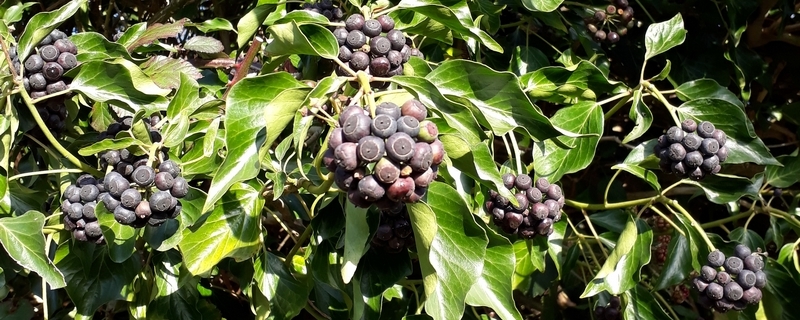The good, the bad and the Ivy
In my previous blog post I included “a controlled amount of ivy” in my suggestions for a native mixed hedge. So this time I thought that I would talk more about this evergreen climber that appears in pretty much every garden, usually uninvited.
As households try to reduce both fossil fuel consumption and energy bills, research has found that a full covering of greenery helps to keep a property cool in summer and warm in winter. So an evergreen like ivy is an obvious candidate. However, I generally do not recommend self-clinging climbers on house walls because they are hard to remove and leave fragments of root or sucker permanently on the wall. Ivy does not damage brickwork or mortar that is in good condition but it needs to be kept clear of tile hanging, gutters and roofs. Shoots can grow under the tiles and lift them from the wall enabling water ingress.
 Ivy in the right spot is great for wildlife: evergreen groundcover where little else will grow or growing up a garden wall or fence, it provides a safe habitat for invertebrates all year round. This is where management is required. You do not want ivy to climb up the trunks into the canopy where its dense foliage is heavy enough when wet to bring down a branch or even a whole tree in a winter storm. Ivy is also very vigorous and can overwhelm a more delicate, ornamental shrub, often unnoticed until the evergreen foliage starts to cover the shrub’s own leaves causing die back. On a wall or fence, the object is to let the ivy form a framework of stems that will produce mature leaves, a pointed oval shape. At this stage the plant will flower, yellowy green globular clusters with stamens but no visible petals. These are a valuable source of pollen for all manner of insects in September and October and then develop into black berries as winter food for birds. Read information on ivy from The Wildlife Trusts HERE.
Ivy in the right spot is great for wildlife: evergreen groundcover where little else will grow or growing up a garden wall or fence, it provides a safe habitat for invertebrates all year round. This is where management is required. You do not want ivy to climb up the trunks into the canopy where its dense foliage is heavy enough when wet to bring down a branch or even a whole tree in a winter storm. Ivy is also very vigorous and can overwhelm a more delicate, ornamental shrub, often unnoticed until the evergreen foliage starts to cover the shrub’s own leaves causing die back. On a wall or fence, the object is to let the ivy form a framework of stems that will produce mature leaves, a pointed oval shape. At this stage the plant will flower, yellowy green globular clusters with stamens but no visible petals. These are a valuable source of pollen for all manner of insects in September and October and then develop into black berries as winter food for birds. Read information on ivy from The Wildlife Trusts HERE.
An annual trim in early spring, after hibernation and before nesting, will grant you and the wildlife all the Good without the Bad of Ivy.
If you enjoyed this blog post, why not subscribe to my monthly free gardening newsletter for all my posts, plus seasonal articles and video tips. Direct to your email in-box. Join HERE and receive my Seven steps to Less effort Gardening.
Happy Gardening from Alison

